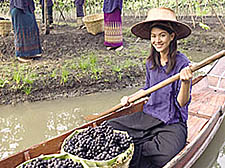|
|
 |
| |

The floating vinyards in Thailand which supply grapes to the Siam winery which makes Monsoon Valley |
New attitude to the new latitude
Try a Thai wine for a drinkable alternative to the French or German tipples
DISMISSED as ‘old world’, European wines were elbowed out of their top selling spots in the UK by trendy ‘new world’ Australian wines.
Now the buzz is ‘new latitude’, a reference to places where, only a few years ago, climatic conditions prevented the production of decent wine. Technology is rewriting the wine-making guide book.
Thailand is a new latitude wine country. Its wine, produced between the 14th and 18th parallels, is outside the accepted geographical position for wine making. The latest edition of Hugh Johnson’s (2005) World Atlas of Wine, makes scant mention of Thailand, instead it advises wine drinkers to keep an eye on China.
But Thai wines are here. There is even a story involving wine experts, confidently judging a blind tasted Thai red wine to be, “very good and French”.
The wine is a Syrah produced by the Chateau de Loei winery, Thailand’s first producer of fine wine founded in the early 1990s by retired construction tycoon and dedicated wine buff, the late Dr Chaijudh Karnasuta.
Dr Karnasuta aimed to supply a growing Thai middle-class, who were deserting Scotch whisky, in favour of French wine, mirroring a similar shift in drinking habits during the 1960s by the British middle-classes.
But it is the Siam Winery – Asia’s largest – which is placing Thai wines on the international wine map. Its founder Chider Yoovidhya (his dad owns 49 per cent of Red Bull, he owns two per cent) began making wine fortified with herbs and spices in 1982. His objective, the supply of suitable alcoholic beverages to drink with spicy food. By 1992 the Siam Winery was licensed to produce genuine grape wines specifically for the Thai market.
Monsoon Valley, a small range of Thai wines aimed at the international market, was launched in 2004. On sale in some European countries, some US cities and the UK, they have concentrated on supplying the booming Thai restaurant sector.
The wines produced by Thais in a modern high tech winery, are made from brought-in grape varieties including – Malaga Blanc (white) and Pok Dum (red) blended with other international grape varieties.
Although marketed as an international wine, Monsoon Valley seeks to re-establish the link between local wines, made from local grapes intended for drinking with local food. Thai wine for Thai food.
While much of the publicity about Monsoon wines is positive, Anthony Rose the Independent newspapers’ food correspondent – writing is 2005 – dismissed Monsoon Valley wines, German Riesling was his preferred wine with spicy food. Is he right?
We took a group of wine drinkers to Thai Smile, a central London restaurant with a good reputation. We also brought along three white wines – only one of which (the Monsoon Valley) was available in the restaurant.
The three wines were a modern Chilean,Vconcha Y Toro Casillero del Diablo; Viognier grape, Monsoon valley white, Malaga/columbard grape and an old fashioned German Riesling, Ewald Pfeiffer Weine,
All three claim the accolade “good with spicy food”. First we tested the wines as aperitifs – drunk without food. The runaway winner was the German Riesling. Next the wines with the food, a platter of Thai starters including Satay chicken and fishcake with dips. Opinions changed radically, the Thai Monsoon Valley emerged as the preferred tipple with the Chilean Viognier a close second.
Our extremely amiable and attentive hosts for the evening were Bhiyada Wongwarachat and her staff at Thai Smile (above the Ivy Bar), 8-10 Southampton Row, WC1. Call 020 7430 9111
|
 |
|
| |
 |
| |
| |
|
 |
|










